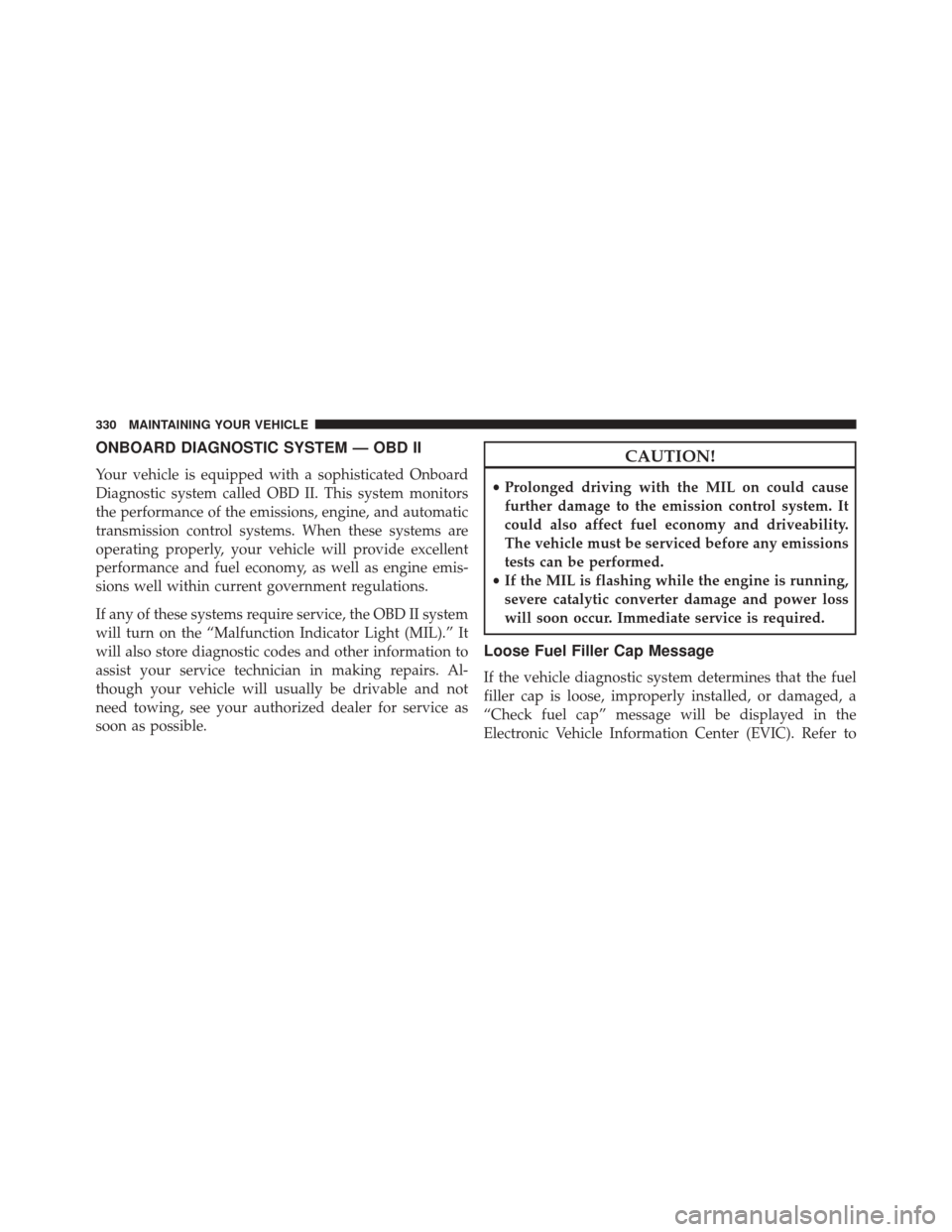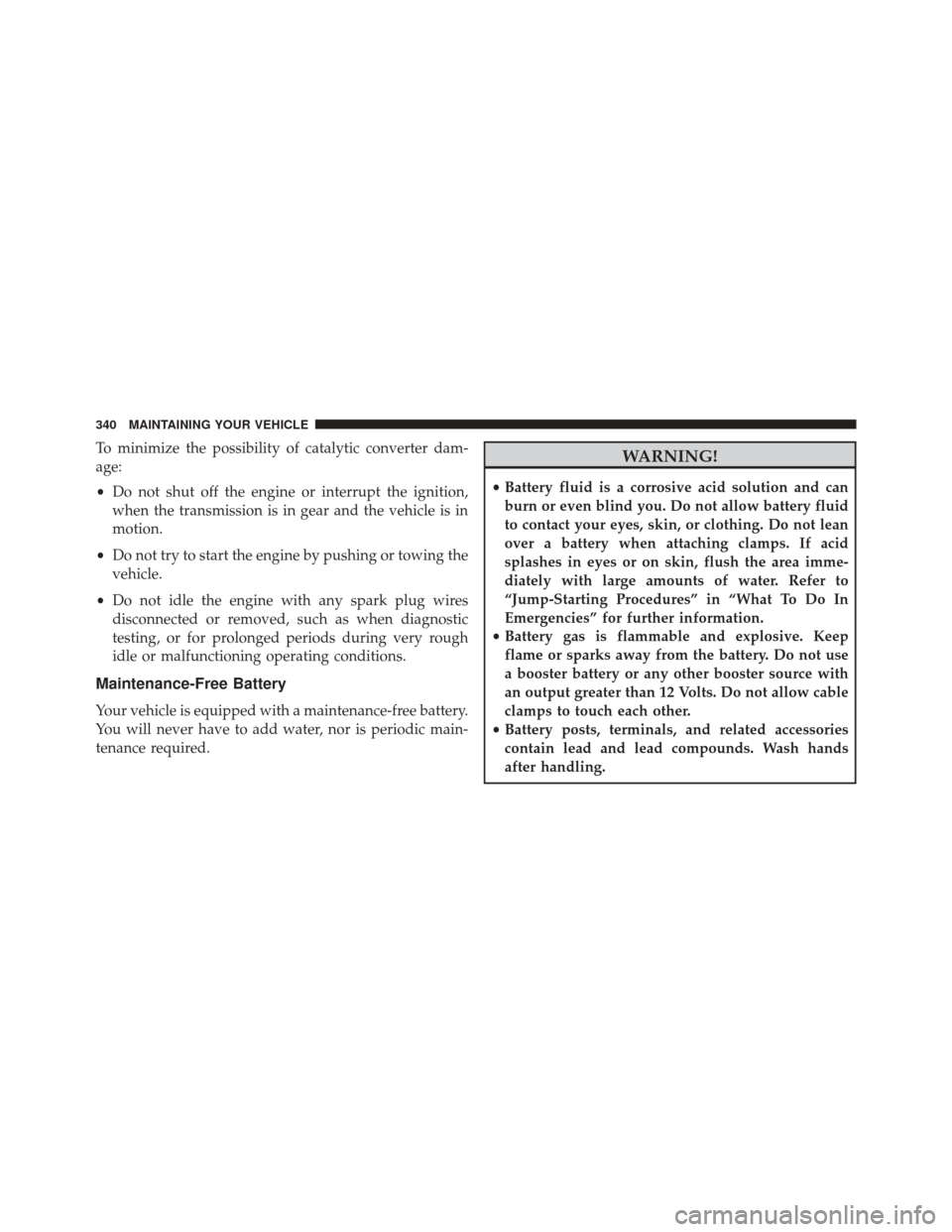Page 288 of 425
�FREEING A STUCK VEHICLE .............323
� SHIFT LEVER OVERRIDE ................324�
TOWING A DISABLED VEHICLE ...........324
▫ Automatic Transmission ................326
286 WHAT TO DO IN EMERGENCIES
Page 326 of 425

WARNING!
Fast spinning tires can be dangerous. Forces gener-
ated by excessive wheel speeds may cause damage, or
even failure, of the axle and tires. A tire could
explode and injure someone. Do not spin your vehi-
cle’s wheels faster than 30 mph (48 km/h) or for
longer than 30 seconds continuously without stop-
ping when you are stuck. And do not let anyone near
a spinning wheel, no matter what the speed.
SHIFT LEVER OVERRIDE
If a malfunction occurs and the shift lever cannot be
moved out of the PARK position, you can use the
following procedure to temporarily move the shift lever:
1. Turn the engine off.
2. Firmly apply the parking brake.3. Using a small screwdriver or similar tool, remove the
shift lever override access cover which is located
below the shift lever.
4. Press and maintain firm pressure on the brake pedal.
5. Insert the screwdriver or similar tool into the access port, and push and hold the override release lever
forward.
6. Move the shift lever to the NEUTRAL position.
7. The vehicle may then be started in NEUTRAL.
8. Reinstall the shift lever override access cover.TOWING A DISABLED VEHICLE
This section describes procedures for towing a disabled
vehicle using a commercial towing service.
324 WHAT TO DO IN EMERGENCIES
Page 327 of 425

Towing Condition Wheels OFF theGround ALL Models
Flat Tow NONE If transmission is operable:
•Transmission in NEUTRAL
• 25 mph (40 km/h) max speed
• 15 miles (24 km) max distance
Wheel Lift or Dolly
To w Rear
Front OK
Flatbed ALL BEST METHOD
Proper towing or lifting equipment is required to prevent
damage to your vehicle. Use only tow bars and other
equipment designed for this purpose, following equip-
ment manufacturer ’s instructions. Use of safety chains is
mandatory. Attach a tow bar or other towing device to
main structural members of the vehicle, not to bumpers
or associated brackets. State and local laws regarding
vehicles under tow must be observed. If you must use the accessories (wipers, defrosters, etc.)
while being towed, the ignition must be in the ON/RUN
position.
If the key fob is unavailable or the vehicle’s battery is
discharged, see “Shift Lever Override” in this section for
instructions on shifting the automatic transmission out of
PARK for towing.
6
WHAT TO DO IN EMERGENCIES 325
Page 328 of 425

CAUTION!
•Do not use sling type equipment when towing.
Vehicle damage may occur.
• When securing the vehicle to a flat bed truck, do
not attach to front or rear suspension components.
Damage to your vehicle may result from improper
towing.
Automatic Transmission
The manufacturer recommends towing your vehicle with
all four wheels OFFthe ground using a flatbed.
If flatbed equipment is not available, and the transmis-
sion is operable, this vehicle may be towed (with front
wheels on the ground) under the following conditions:
• The transmission must be in NEUTRAL.
• The towing speed must not exceed 25 mph (40 km/h). •
The towing distance must not exceed 15 miles (24 km).
If the transmission is not operable, or the vehicle must be
towed faster than 25 mph (40 km/h) or farther than 15
miles (24 km), tow with the front wheels OFFthe ground
(using a flatbed truck, or wheel lift equipment with the
front wheels raised).
CAUTION!
• Towing faster than 25 mph (40 km/h) or farther than
15 miles (24 km) with front wheels on the ground
can cause severe transmission damage. Damage
from improper towing is not covered under the
New Vehicle Limited Warranty.
• Towing this vehicle in violation of the above re-
quirements can cause severe transmission damage.
Damage from improper towing is not covered un-
der the New Vehicle Limited Warranty.
326 WHAT TO DO IN EMERGENCIES
Page 332 of 425

ONBOARD DIAGNOSTIC SYSTEM — OBD II
Your vehicle is equipped with a sophisticated Onboard
Diagnostic system called OBD II. This system monitors
the performance of the emissions, engine, and automatic
transmission control systems. When these systems are
operating properly, your vehicle will provide excellent
performance and fuel economy, as well as engine emis-
sions well within current government regulations.
If any of these systems require service, the OBD II system
will turn on the “Malfunction Indicator Light (MIL).” It
will also store diagnostic codes and other information to
assist your service technician in making repairs. Al-
though your vehicle will usually be drivable and not
need towing, see your authorized dealer for service as
soon as possible.
CAUTION!
•Prolonged driving with the MIL on could cause
further damage to the emission control system. It
could also affect fuel economy and driveability.
The vehicle must be serviced before any emissions
tests can be performed.
• If the MIL is flashing while the engine is running,
severe catalytic converter damage and power loss
will soon occur. Immediate service is required.
Loose Fuel Filler Cap Message
If the vehicle diagnostic system determines that the fuel
filler cap is loose, improperly installed, or damaged, a
“Check fuel cap” message will be displayed in the
Electronic Vehicle Information Center (EVIC). Refer to
330 MAINTAINING YOUR VEHICLE
Page 342 of 425

To minimize the possibility of catalytic converter dam-
age:
•Do not shut off the engine or interrupt the ignition,
when the transmission is in gear and the vehicle is in
motion.
• Do not try to start the engine by pushing or towing the
vehicle.
• Do not idle the engine with any spark plug wires
disconnected or removed, such as when diagnostic
testing, or for prolonged periods during very rough
idle or malfunctioning operating conditions.
Maintenance-Free Battery
Your vehicle is equipped with a maintenance-free battery.
You will never have to add water, nor is periodic main-
tenance required.
WARNING!
•Battery fluid is a corrosive acid solution and can
burn or even blind you. Do not allow battery fluid
to contact your eyes, skin, or clothing. Do not lean
over a battery when attaching clamps. If acid
splashes in eyes or on skin, flush the area imme-
diately with large amounts of water. Refer to
“Jump-Starting Procedures” in “What To Do In
Emergencies” for further information.
• Battery gas is flammable and explosive. Keep
flame or sparks away from the battery. Do not use
a booster battery or any other booster source with
an output greater than 12 Volts. Do not allow cable
clamps to touch each other.
• Battery posts, terminals, and related accessories
contain lead and lead compounds. Wash hands
after handling.
340 MAINTAINING YOUR VEHICLE
Page 411 of 425

Corrosion Protection.......................355
Cruise Light ............................ .128
Cupholders ..........................118,361
Customer Assistance .......................397
Customer Programmable Features .............169
Data Recorder, Event .......................51
Dealer Service ............................333
Defroster, Windshield ....................66, 186
Diagnostic System, Onboard .................330
Dimmer Control ...........................92
Dimmer Switch, Headlight ...................94
Dipsticks Automatic Transmission ..................354
Oil (Engine) .......................... .334
Power Steering ........................ .218
Disabled Vehicle Towing ....................324
Disposal Antifreeze (Engine Coolant) ................350Door Locks
..............................20
Door Locks, Automatic ......................22
Driving Through Flowing, Rising, Or Shallow Standing
Water ............................... .215
Electric Remote Mirrors ......................73
Electronic Brake Control System ...............221
Brake Assist System .....................223
Electronic Speed Control (Cruise Control) ........101
Electronic Stability Control (ESC) ..............224
Electronic Vehicle Information Center (EVIC) Exit Trip ............................. .146
NewTrip ............................ .146
Start Of Trip Procedure ...................146
Trip Computer ........................ .146
Trip Functions ........................ .147
Emergency, In Case Of Freeing Vehicle When Stuck ................323
10
INDEX 409
Page 414 of 425

GaugesFuel .................................128
Odometer ............................ .128
Speedometer ..........................128
Tachometer ............................128
Gear Ranges ............................ .205
Gear Select Lever Override ..................324
General Information ....................183, 261
General Maintenance .......................128
Glass Cleaning .......................... .360
Gross Axle Weight Rating ................269, 272
Gross Vehicle Weight Rating ..............269, 272
Guide, Body Builders ........................6
GVWR .................................269
Hazard Driving Through Flowing, Rising, Or Shallow
Standing Water ........................ .215
Hazard Warning Flasher ....................287 Headlights
Cleaning ............................ .359
High Beam ............................94
High Beam/Low Beam Select Switch ..........94
Passing ...............................94
Switch ................................92
Head Restraints ...........................86
Heated Mirrors ............................74
Heated Seats .............................85
Heater .................................183
Heater, Engine Block .......................202
High Beam/Low Beam Select (Dimmer) Switch .....94
Hill Start Assist .......................... .228
Hitches Trailer Towing ........................ .274
Hood Release .............................89
Ignition .................................11
Key..................................11
412 INDEX